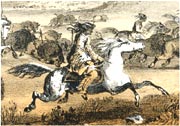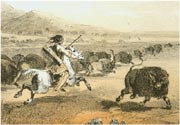| (As told by Many-Tail-Feathers)
“Our far-back fathers soon found that nothing was so exciting,
so satisfying as the running of a herd of buffalo with a fast, well-trained
elk-dog. With a good bow, a quiver of arrows, and such a horse, a hunter
could often select and kill ten or twelve fat cows in a single run.
So was it that piskans were not used so much for obtaining plentiful
supplies of meat and hides. Still, used they were, for, as some of
the wise, old, Sun’s men said, it was not right to let old and
sacred customs die.
“A favorite piskan of our Pikuni tribe was the one on the south
side of Milk (Teton) River and just below Old Man Lying Butte. When
I was in my eighth summer (approximately 1843), we Pikunis moved from
Two Medicine Lodges River to camp, for my father, Many-Tail-Feathers,
who was a powerful decoyer, had long been urging our chiefs that we
use the piskan there, and at last they had given into his plea. He
was a great warrior as well as a decoyer. He was married to three sisters;
my mother the eldest one, was his sit-beside-him-wife.
| “We made camp on the north side of the river, opposite
the piskan on its south side. On the following morning
my father and our chiefs climbed to the top of the sacred
butte for a look at the country, and I followed them.
We arrived upon its flat top. There, long since, some
of our Sun’s men had, with many white stones, made
a figure, very large, of Old Man" (a powerful but mischievous
god of the Blackfoot tribes). Yes, it was a very large
figure of him, his arms and legs outstretched. When we
stopped before it my father made a prayer. ‘Haiyu,
Old Man!’ he chanted. ‘Pity us, help us to
prosper. Our piskan, there close below us, help me fill
it with buffalo.’ And as one man the others chanted: ‘Haiyu,
Old Man! Help us to prosper! Give us a long and full life.’ |
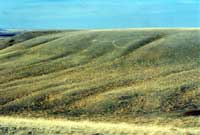
Old Man Lying Down Butte.
Photo from Lifelong learning Project files.
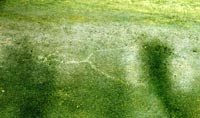
Close-up of Old
Man’s
image in stone,
on side of butte.
Photo from Lifelong learning Project files.
|
| |
|
| “We then sat down and looked off. In all directions,
near and far, the plain was dotted with herds of buffalo
and antelope, some grazing, some resting, others going
to and from water. Said my father: ‘Sun is good
to us; just see how plentiful are the animals that he
created for our use. Let us smoke and pray to him.’ |
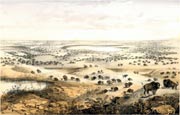
Buffalo near Jessie Lake
from lithograph by J.M. Stanley original, ca. 1854. (Stevens:
1861)
Courtesy of The University
of Montana, Mike and
Maureen Mansfield Library,
Government Documents.
|
“Four pipefuls, sacred number, they
smoked one after another as they prayed to Him, sang His
sacred songs, and then we returned to camp. Many of our
people,
with their horses, were drawing old logs and tree branches out to
repair and heighten the piskan. Not a cliff piskan, it was
at the mouth of a small, short
coulee running down from the plain, and the cut bank at its inner
side was just high enoughto prevent the buffalo jumping
back out of it. From the head of the
coulee, of course, ran the two ever-diverging lines of rock piles,
and just beyond them was the little ridge so necessary for
preventing a herd, farther out, from
seeing the decoyer and the frighteners hurrying out to take their
various places.
“Came night, and in our lodge my father and some of his friends smoked
and prayed Sun for quick success at the piskan. Ha! Before the middle of next
day our watchers came hurrying down from Old Man Lying Butte with news that a
herd of buffalo were resting close out from the decoyer’s ridge. At once
the frighteners began running out to take their places, I going with my mother
and almost-mothers. With a few others we dropped down at a rock pile of the right
line and well out from the piskan. Then came my father, but not afoot as had
been the far-back decoying way. He was riding a brown horse upon whose head he
had fastened a dried head-skin and fur and horns, and even the chin whiskers
of a buffalo bull, and he was wearing a buffalo robe, fur side out. Swiftly he
rode past us and up the ridge. Nearing its top, he bent overflat upon the horse
to imitate the hump of a buffalo. So arriving upon the top of the ridge, he appeared
to the resting herd beyond to be one of their kind. Shouting ‘Whoo hoo!
Whoo hoo! Whoo hoo!’ he rode down toward them a way, them turned and hurried
back, up and over the ridge and out of their sight. Again and again he repeated
that going and coming and whoo-hooing, all of us frighteners closely watching
him as we prayed Sun to give him success, to keep us safe. There was always danger
for the frighteners; more than once an oncoming herd had swerved, broken through
a line of them, and trampled several of them to death. My mother gave me a scared
feeling, made my eyes wet as she prayed, ‘Oh Sun! This day I give you my
new beaded dress. So is it that I pray you to give my man success. And we poor
ones, oh Sun! Make the buffalo run straight to the piskan. Oh, prevent them from
turning and cutting us to pieces with their sharp hooves.’
“Six times my father ran down the ridge a little way , whoo-hooing to the
herd and then as he came back over it he did not stop; on he came, fiercely quirting
his horse, and over the ridge came the buffalo after him. As soon as they were
well within the lines of rock piles the frighteners began rising and yelling
and wrap-waving at them. They had come down off the ridge well scattered, but
now, terribly frightened, they bunched close together and ran even faster, the
thudding of their hooves like thunder in our ears. Soon my father turned his
horse, rode out through the left line of the frighteners, but the buffalo were
no longer after him. What they did see and fear was the shouting and waving of
us frighteners, continually rising upon their either side and running after them.
So on they ran, straight ahead into the little coulee and jumped off the cutbank
into the piskan, we frighteners singing and yelling, hurrying thither. Oh, what
a satisfying sight it was, that great piskan filled with buffalo, as later counted
181 of them; our hunters on top of the piskan, with guns and with bows and arrows
shooting them. I climbed up onto the piskan beside my father, reloading his flintlock
gun. ‘Give it to me. Let me kill one!’ I yelled.
‘No! You are too young for that,’ he said. But I grasped his arm,
hung onto it, pleaded hard, and at last he handed me the gun . I aimed it at
a yearling close by; aimed for the ball to pierce the lungs. I pulled the trigger,
and down off the piskan that kicked me flat upon my back. My father and the others
near by laughed at me. I climbed back upon the piskan and looked down: my yearling
was dead.
‘Laugh, you crazy ones; I don’t care. I have killed a buffalo,’ I
yelled.
“Said my father as he recovered his gun: ‘So you have, my son. Next
time hold the gun tight against your shoulder and it will not kick you.’
“Men and women, boys and girls, we all worked hard the rest of that day
in butchering the many buffalo, and with pack horses and travois horses getting
the meat and hides across the river to camp. And then what a happy evening for
us all! My father’s friends were constantly coming to our lodge to smoke
with him and praise him for his decoying of the herd. There was some feasting
and smoking and singing
in nearly every lodge“ (Many-Tail-Feathers, in Schultz 1962: 312 -315).
|

